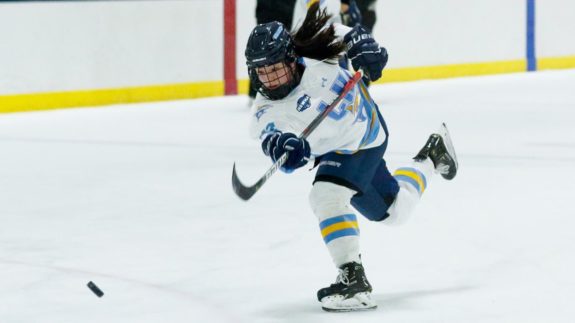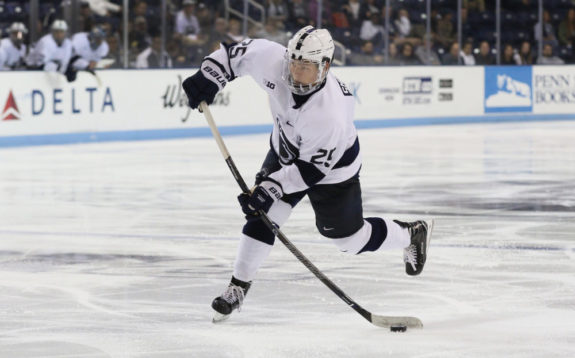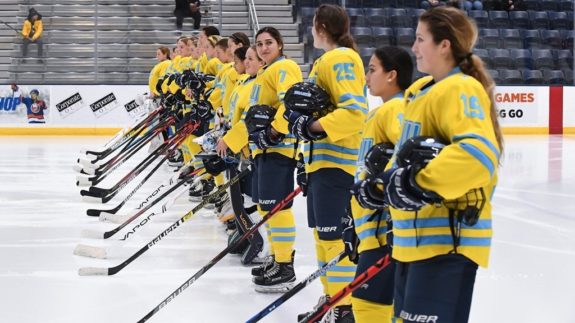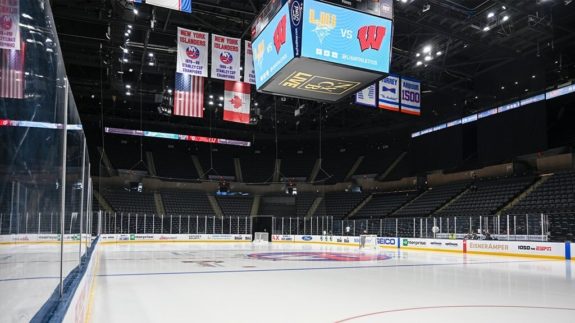With the current state of society, there has not been a whole lot of news around the world of college hockey. With the exception of graduating players signing pro contracts, it has been a quiet month since the postseason awards were announced early in April.
That was, until this past Thursday, when Long Island University dropped a bomb, announcing they were going start up a men’s D1 hockey team. This is obviously great news for the sport of college hockey, adding another program to the fold to further grow the sport at the university level.
Here’s the catch… they have to be ready in less than five months.
Getting to Know LIU
Hockey is certainly a new sport on the campus of Long Island University, with women’s D1 hockey taking to the ice in the 2019-20 season. The Sharks finished fourth in the New England Women’s Hockey Alliance (NEWHA) standings, before beating Saint Aslem University to claim the conference championship. Along with their team success, the Sharks also possessed talent who won individual awards as well.

LIU is a Division 1 school, with the majority of their sports competing in the Northeast Conference (NEC), with some playing in the Eastern Collegiate Athletic Conference (ECAC).
Too Soon?
The Sharks will become the 61st program in NCAA Division 1 hockey, and there is no question, making the jump to D1 is not easy. Just ask Arizona State, who went 3-22 against D1 teams in the program’s first season back in 2015-16. It is even tougher to put together a program from scratch in a span of five months. The most recent additions such as Arizona State and Penn State at least had successful club hockey programs in the American Collegiate Hockey Association (ACHA) before becoming varsity sports, along with significant financial support.

While coming out of the blue does raise a few eyebrows, the task of hiring a coaching staff along with recruiting a full roster on such short notice makes Long Island’s decision even more mind-boggling. There were whispers that the University of Illinois and Navy were planning on making similar announcements as well, but paused with the rest of the world due to the pandemic.
Related: Who Invented Hockey?
Regarding the Sharks, it is difficult to see them put together a competitive team in such a short time. Granted, the women’s team was able to put together a successful postseason (in a conference of only six teams, albeit), but the Sharks are smack dab in the middle of the northeast region of the U.S. that Hockey East, Atlantic Hockey and ECAC all call home. Nine teams from those three conferences held spots in the final top-20 rankings of the season. To say the competition level will be tough is a huge understatement.
Where Will They Play?
There are many great barns around the spectrum of college hockey. The new home of the Long Island Sharks will have to try to stack up to the great arenas such as Ralph Englestad Arena (University of North Dakota), Mariucci Arena (University of Minnesota) and Yost Ice Arena (University of Michigan).
So, where will the Sharks home rink be?
The women’s Sharks team played in three different rinks last season. Syosset Iceworks and Northwell Health Ice Center (both are training facilities for the New York Islanders), along with playing a game at Nassau Coliseum against Wisconsin in October. With the program being announced only last week, the location for the team’s home games is down the list of the things to worry about at the moment. That said, let’s look at the options they have.
Iceworks (Syosset)
By convenience, Iceworks would be the best bet for the Sharks, given that it is only 12 minutes away from LIU’s main campus in Brookville. However, fan capacity is at minimum, as it is your typical public rink setup.
Northwell Health Ice Center (East Meadow)
Located 16 minutes from the main campus, Northwell is a state-of-the-art facility built in 2016.

It features two indoor rinks, with more seating capacity than Iceworks, and also includes an outdoor rink and fantastic training facilities used by both the Islanders and minor hockey teams that call the rink home.
Nassau Coliseum (Uniondale)
Then there is the famous Nassau Veterans Memorial Coliseum. Located less than 20 minutes from LIU’s campus, it is not a far drive to one of the most historic venues in the NHL. It has been recently renovated, with the Islanders still using as one of their home rinks. With the current status of the COVID-19 pandemic, it would be quite the financial risk to rent out the arena with the possibility of not being able to have fans in the building.

Taking all of that into account, signs are pointing to the Sharks staying as close to campus as possible, therefore Iceworks seems to be the best option. With more of the focus placed on the team on the ice, rather than building and in-seat fan base. It is inconceivable to see LIU try to build a team inside of a bigger venue such as Nassau.
The Money Situation
The big issue that the new Sharks’ hockey program will be facing is the team’s budget. While the official budget has not been announced, there have been whispers of how low it is going to be. Mike McMahon of College Hockey News reported, from a source, that the necessities of running a college hockey team would eat up the majority of the planned budget.
One portion of the budget that has been confirmed is the salaries of the coaching staff. According to multiple reports, the staff will include a head coach, along with two assistants. The maximum combined salary between the three of them? $150,000. After talking with multiple Sports Information Directors (SIDs) from the Western Collegiate Hockey Association (WCHA), each head coach in the WCHA is making at least six figures. Some, obviously, make more than others based on their respective team’s budget.
Related: Hockey Documentaries to Watch Right Now
In ensuing conversations with the SIDs, the median budget to run a hockey team costs around $600K-$700K, with some schools exceeding the $1 million threshold. However, these include teams who have had programs for decades, not teams that are just starting out. From all parties who have chimed in, it does not sound like LIU is putting enough money into starting up the new team.
The Red Flags
Number one issue has to be the coaching budget. Multiple coaches have already declined the head coaching job since last Thursday, most citing that their salaries would be too low compared to other D1 coaches. Even if a coach accepts the job, he is going to be given the burden of trying to recruit an entire hockey team by August before training seems a lofty goal.
Simply recruiting a competitive team is going to be difficult as well. Not just due to the fact that prospective student-athletes may not have the chance to see the campus before next season starts, but also because many of the top recruits have already signed committments to other schools. Getting embarassed in year one is something the Sharks are going to want to avoid, but it will be tough to put together a competitive team with the leftover talent still available.
Long Island Athletic Director Dr. William E. Martinov Jr. has claimed the team will play at least 20 games next season, with hopes of picking up games against other teams in the region. Contrary to the path of Penn State and Arizona State, who put together a bigger schedule, based with a majority of D1 opponents, with some D3 and ACHA teams mixed in order to build the program up before fully diving in to D1 competition.

Another strange move by LIU was them omitting help from College Hockey Inc. CHI is one of the biggest marketing arms that is dedicated to help grow the sport around the U.S. Both Arizona State and Penn State used CHI to help market their new programs, and it has helped both teams gain immediate success. CHI has come out and said they had no inclination of LIU making the move to NCAA before the announcement.
A first-year program always has its trials and tribulations. Yet, teams have at least put forward the effort to create a solid foundation in order to set up for a successful future. What LIU has shown so far is that they may not have quite thought about what they are trying to accomplish through enough. Whether it be the time frame to put the team together, or the lack of funding to acquire the appropriate assets, it looks like a rocky road for the new kids on the block in the NCAA. (from ‘The Daily Skate: Long Island University to launch D-I men’s hockey program. . . in five months,’The Daily Skate: Long Island University to launch D-I men’s hockey program. . . in five months,’ Grand Forks Herald, 05/02/2020)